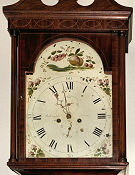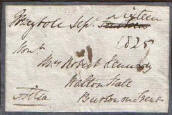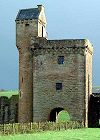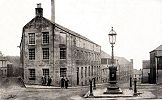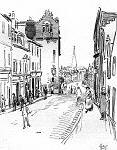Do you have an article or story of interest you would like to share with visitors? Contact us
|
This letter dated 1787 has been in my family for generations. It is from Petersburg which I take to be in Virginia USA and not the St Petersburg in Russia but I have no way to verify this. I lived in Maybole as did my parents and grandparents, at Woodside on the Main Street opposite Jacks factory. My grand father was a vet, Walter Gardner married to Annie Ferguson, my father was Walter Gardner married to Johan Boa. I do not know anything about the letter except that is was in my father's safe folded up into a small square. I took it to the local archivist here in Dumfries as I could not work out what 'flesh and Graind' meant but it may be polished leather and suede. Johan Findlay more |
|
Maybole Red Cross - 1918: The Maybole Division, which comprises Maybole, Crosshill, Kirkmichael, Straiton, Kirkoswald, Fisherton, and Dalrymple, is under the Vice-Presidency of Mrs. Hunter-Blair. The Maybole Work Party numbers 150 members, and in 1917, 2278 garments were made, bringing the total since its formation up to 10,535....In 1916 Maybole subscribed for a bed in Bellahouston Hospital, and for one in the Rouen Hospital, each of which was named " The Capital of Carrick Bed." The year the town subscribed for one at Seafield, which was named "The Maybole Bed". more |
|
The clock is probably from the early to mid 19th Century when this type was in style. It is a typical 8-day weight driven movement with a white painted dial. The Hepplewhite case is a combination of mahogany and mahogany veneer with inlaid stringing. Some additional points about this clock and British clocks in general: I acquired this clock from someone who knew nothing about its background which is fairly typical. Many tall case clocks were imported to the US by antique dealers after WW II and sold to collectors for decoration. Information about ownership prior to that time is of course lost. Read the rest of the story |
|
Dear Madam: It is with the very deepest regret and sympathy that I have to confirm the news, which you have no doubt received by telegraph, of the death of your son, 1st Liet. George Squires, who was at the time attached to this School for a Course of Instruction in Aerial Fighting and Gunnery. I beg to give you the following brief particulars of the fatal accident and of the funeral arrangements. On Saturday May 18th, at 10:30 in the morning the machine of 1/Lt.G.Squiree, who was carrying out practice in certain fighting evolutions, was seen to circle slowly and begin descending, the descent taking place apparently normally until the machine dived at a steep angle and crashed to the ground. Your son was in sole control of the machine, no passenger being carried on the type he was flying. Read the rest of the story here |
|
A well-known clockmaker (whose clocks are now much sought after) had a shop in High Street and was known to all as "Watchie Logan" early last century. He travelled the district repairing clocks in the farmhouses and was fond of a dram after he had done his work. On one occasion he was at West Enoch attending to a clock when the farmer was over generous with his bottle and "Watchie" left for home in a happy, but rather sleepy, condition. On reaching the "Beggars Rest" he sat down and fell asleep and some of the weavers who had been for a walk round the "Cross Roads" found him snoring away completely oblivious to everything. For a ploy they put him into a sack (he was a very small man) and carried him down to the back shop of a local butchers where they told the butcher they had poached a deer on Mochrum Hill and would let him have it for ten shillings. Read the rest of the story here |
|
Wes Muir, who lives in North Carolina, USA found his grandfather's journal in an old truck a few years ago. From the journal Wes discovered that his grandfather lived in Maybole but left for America in 1861 with his two nephews. They made their way to Liverpool and purchased passage on a large three-masted ship called the Benjamin Adams. His journal tells the story of the 55 days journey across the Atlantic Ocean arriving in New York three months after the beginning of the American Civil War.
One particular entry of note near the end of the journey is that of 16 July 1861 just after America's Civil War had begun. A Union navy ship fired a warning shot at the ship John Muir and almost 400 passengers were aboard. The ship stopped and was boarded by the Union navy which was looking for a Confederate privateer ship called the Jefferson Davis. Satisfied that this was not the ship they were allowed to proceed to New York.Wes Muir. Read the story here |
|
The first edition of The Maybole Chronicle was published the 20th of October, 1923. At a price of One Penny it was stated to circulate in Crosshill, Kirkmichael, Kirkoswald and Straiton. This is the only edition of this newspaper known to exist. Were there any more editions? We don't know. Perhaps a site visitor can tell us. Please contact us if you have an answer to this. Excerpts from Page 1. A Terrible Tragedy in life befalls the man of woman who doesn't know how or where to spend Money to the Best Advantage but by making your Purchases Direct at "Ye Olde Outfitting Establishment of Wright" you eliminate all risk. If Winter Comes, and you are not prepared...it may mean the flu. Avoid this by getting good underwear. Buy the Wolsey. Sold by T. Hicks, Outfitter. 80 High Street Maybole. |
|
Maybole website received the following inquiry- Greetings from the Colonies! My parents bought a china cabinet locally. On the cabinet is a brass plaque which states that it was presented to Miss Ann Brannan upon her retirement from Cairn School, Maybole in June 1932. The cabinet resides in corner in the front room out of direct sunlight (we watch The Antiques Road Show over here as well) and holds my mother's treasures. How the cabinet made it from Scotland to New Westminster, British Columbia is a mystery as is Miss Ann Brannan. Could you please point me in the direction of any sources of information about her. Any info! Photo! Anything! Thanks for your time and attention. Len Osmond Read our response here. |
|
Confession and last Words of Thomas Neilson, who was Executed at Maybol, on Thursday, being the 14th of August, 1718. For Murdering one Named MíConnel, in the Parish of Girvan. For the better Understanding of the ensuring Discourse, it will not be amise to Relate how this matter began. The Murdered, and the Murderers, dwelt in a Mealing together, in Daldouy in the Parish of Girvan, and were every way Partiners (but the Neilsonís besides were Cowpers to their Employment ) Itís Storied that the Man Murdered was a Rubust stormy sort of a Man .... Read the article. |
|
A shoemaker from Maybole was stuck in the eye by a golf club. Here is the painfully story of the state of eye surgery in 1819. The account below is an excerpt from a book titled A Manual of the Diseases of the Human Eye intended for Surgeons commencing practice. Berlin 1819. Translated from the original German Work by George C. Monteath, M. D. ...The following case of Bony Cataract may be worthy of being recorded. In September 1819, I was consulted by Gilbert M'Crindle, a shoemaker from Maybole, by the desire of Mr. Train, his medical attendant, from whose obliging account of his case I extract the following concise history. Read the article |
|
The Great Debate at Maybole 28th, 29th and 30th September 1562 ĎHeir followeth the coppie of the ressoning which was betuix the Abbote of Crosraguell and John Knox, in Mayboill concerning the masse : in the yeare of God, a thousand fiue hundreth thre scoir and two yeares.' The best way of understanding history is to get inside the minds of the main players at any given time, and the best way of doing this is to look at some of the things they said and did particularly in unguarded moments. Scotland in the early years of the 1560ís was in considerable turmoil. In August of 1560 parliament in Edinburgh had passed an Act establishing a new protestant church and forbidding the saying of Mass anywhere in the country, but it quickly became apparent that this law, since it did not have the Royal Assent, was being widely ignored. Read the article. |
|
Another Mystery. Can you tell us more about this? Local writer Catherine Lucy Czerkawska purchased this at a local auction recently and said - "it is a very old embroidery on silk - the faces are actually painted though the costumes, landscape etc are embroidered. It is Mary Queen of Scots escaping from Leven Castle. On my way out of the auction room, I was met by the lady who had sold the embroidery - she confirmed that it depicts Mary, that it is about 200 years old, and - much to my interest - added that it "came from a house in Maybole." BI would be very interested in finding out anything more about it and its provenance. more |
|
A small mystery. Can you tell us more about this envelope? The item was purchased on eBay by Sally Walker (Nee McCubbin) with the description given as: 1825 "free Front" only signed "Ailsa" Marquis of Ailsa? at Maybole Ayrshire. Unusually the date has been altered from "fourteen" to "sixteen". Front is mounted on dark blue backing paper. The paper measures 3" X 5". Sally says "the front of the envelope is addressed to Mrs Robert Kennedy, Halton ( or Hatton?) Hall, Burton on Trent, dated 16/9/1825 and noted "Ailsa" in the bottom left corner. I suppose it is a letter from the Marquess of Ailsa to a sister in law?" Click here or on the image to view full size. |
|
An Address Delivered in the precincts of Crossraguel Abbey
on 16th July 1933 by Rev. David Swan, B.D. Maybole. Rev. Swan's address
found in the kist at the Parish Church. Transcription done by Gordon
Killicoat with photos by Brian Wotherspoon. Next time you travel to Glasgow by rail, look out of the carriage window immediately after you have passed Paisley Station. There on the right hand you will see Paisley Abbey, within recent years restored to something of its ancient dignity and glory. There is a shadowy tradition that Sir William Wallace, the knight of Ellerslie and the Scottish patriot, received his schooling in a seminary attached to the Abbey. The full text here. |
|
BOOT & SHOEMAKING IN MAYBOLE. This article was written and contributed by J. Murray Cook with illustrations from ĎThe Kingdom of Carrick and its Capitalí by John Latta and William Millar, 1904. It is remarkable how a population of weavers, in one generation, became a population of souters (shoemakers) or curriers. All my great great grandfathers were weavers, all except one of my grandfathers were souters or curriers. In 1838, John Gray & Co. began producing hand sewn footwear using local outworkers to stitch pre-cut soles to uppers. He had a place in Inches Close, now the entrance to Safeway car park, where he would employ boys at 6d a week. |
|
I am seeking information about some sterling flatware that I my father bought in the 1950's, at a auction house in New York City. The 209 pieces of sterling flatware are stored in a big wooden case with the name The Earl of Carrick on the outside. There are three hallmarks on the pieces but the only one I can recognize looks like the fish part of the Clan Kennedy Badge. I read on the Maybole website that Archibald Kennedy lived in New York City in the mid 1700's but on his refusal to take part in the Boston Tea Party, George Washington's evicted him from his home and took possession of it for himself. I just wonder if this set belongs to Archibald or his wife, "Anne Watts" the lady that he married. The jeweler told me she hasn't seen silver like this outside a museum. Can you solve this mystery for us? |
|
In Mayboleís West Church is a stained glass window with the following dedication.
ERECTED BY JAMES AND AF
DUNLOP, CONCORD, MASS
Church members were curious to know if there was some way
to find more about the Dunlops of the USA and their sister Margaret. The
original records for the construction of the window were not available so
that made answering this question a bit of a challenge. |
|
An excerpt from the SUN newspaper. London: Saturday 27th September 1800 includes a lengthy account of the trial at Ayr of John Andrew, a shoemaker and at one time a teacher, and Robert Ramsay, a cartwright, both of Maybole. They were accused of sedition and administering unlawful oaths at a meeting of Freemasons and-or Knights Templar in Maybole at some time in 1796. Click here or on the image to the left. |
|
Three Letters and an Invitation to a Funeral ...Yes John it is a warning to us to live as we ought to do and prepare for that dreadful event that sooner or later awaits us all. We should leave nothing to the last as a Death bed has often enough to do with itself. It was a most heart rendering scene to see Mrs. Jamieson suffering her dear Husband in his last moments and with that calm resignation of a true christian she closed his eyes and mouth with her own hands and resigned him to his GodÖJessie Jamieson to her brother John, 16th Dec 1833, Maybole. Click here or on the image to the left to read more of the story. |
|
This image of a Burgess ticket dated 1836 was contributed by Richard McRonald. Thomas McRonald, named as a Burgess on the ticket, was his great great grandfather. A transcription of the document precedes it and is followed by a brief history of the McRonald family in Maybole. Click on the image on the left to view it. |
|
A DRAMATIC day in Maybole as smoke billows from the historic castle. And the townspeople gather in the High Street to watch the battle to save the building. Local history expert Davie Hunter says the fire occurred in 1919, when only very basic fire-fighting gear was at hand in the town. Click on the image to the right to view the article as it appeared in the Ayrshire Post in July 2001 or here to view a large photo. |
|
Edwin Lawrence looks back to the days of a thriving town that led the British Empire in shoemaking. ...Census returns from 1901, show Maybole as the second-biggest town in South Ayrshire. Boot and shoe making helped give Maybole its large population, and the town was the hub of an area that employed hundreds more in agriculture, weaving and mining. |
|
The shoes and boots produced by Maybole's factories were known throughout the world in the latter part of the nineteenth and early part of the twentieth century. "By 1891 there were ten shoe factories in full production employing 1,500 workers and producing about one million pairs of boots and shoes annually. Shops were opened throughout the whole of Britain, named "The Maybole Shoe Shop". |
|
Can you help us solve this mystery? What is the origin of this tapestry and what story is it from? These photos were sent to us by John Fraser who says that ... I believe this is a tapestry that depicts the scene of the elopement of the Countess of Cassillis and the Gypsy King. It was given to my father by his Aunt from Scotland. We can follow it back about 80 years or so. She told him it was called the Elopement. What I was wondering, was how old it might be and where it came from. Click here or on the image for more. |
|
A Fatal Accident at Ailsa Craig. Contributed by Andrena Wallace. "A fatal accident took place on Saturday at Ailsa Craig. A boating party had proceeded there for a day's pleasure, and amongst the company were some boys. One of them Robert Girvan, 10 years of age, son of David Girvan, dairyman, Turnberry, had gone with others to climb for sea bird's eggs, and not turning up search was made for him .... Click on the link above or the photo for the full story. |
|
|
FIVE SUNDAY SCHOOL TRIPPERS DROWNED. RECKLESS USE OF AN OLD BOAT. The tragic result of a boating episode indulged in on the Carrick shore on Saturday by a party of Sunday School trippers from Kirkmichael, created great consternation all over the county when it became known on Saturday evening. Eleven persons, mostly children were involved, and five lives were lost, the victims being a ploughman and four children. June 1910. Contributed by Alistair Hastings. |
|
A.
JACK & SONS, Ltd., Agricultural Engineers, MAYBOLE. |
|
MISFORTUNES SELDOM SINGLE.-- A few days ago, the wife of a poor labourer named Barnard McVae, residing at Goatís Green, Maybole (better known by the youngsters as Mary Meikleís Shore) having been confined, one of her children about two years of age, while amusing itself about the doors tumbled into the well and was found there drowned by a neighbour who had gone there for water. - On Friday last, the father coming into the town to look after some work having, it is said, partaken too freely of spirits, missed his foot at the top of a stone stair in a house at "Patís Corner," fell to the bottom and was killed! Ayr Advertiser, April 10th 1851 |
|
The
Kennedy Family - "The Kings of Carrick" |
|
The Postal History of
the Kingdom of Carrick |
|
The Riot at Deans Mill: A Disturbance in Maybole, 1831. "Twelve men were charged with being part of the mob which had advanced upon Deans mill in a "riotous and tumultuous manner, to the terror and alarm of the lieges, and the disturbance of the public peace" and which did "in a violent, and illegal, and tumultuous manner...break in pieces and destroy the machinery". Click on the link above to read this fascinating account recently reported in Ayrshire Notes by David McClure. |
|
|
The Rev.
Roderick Lawson wrote the West
Parish Monthly Letter for over 17 years, the first being issued in
April 1880. The circulation was about 1600 with
about 1100 being distributed in the town of Maybole and 500 sent to
different parts of the world.
West Parish Letter dated June 1891 |
|
Maybole Town and other poems by John Fulton: Far up amongst auld Carrick hills 'Mongst crystal springs and glittering rills, 'Mongst shady trees and scented thorn, Whaur wild birds' song wakes early morn, Stands Maybole Toon, 0' ancient glory Famed in romance, in song and story, Whose sons for freedom always fought, And with their blood new glory bought On monys a gory field.... Click on the link above to view the rest of the page. Contributed by Gordon Macfarlane. |
|
|
The Maybole Ragged School: browse the school minutes and 30 pupil accounts such as this: James Thomson: 13 years of age father dead; was brought to school the 29th day of January 1849. this boy was well known to be a notorious thief and a town pest. He was ignorant as a heathen, neither knowing a letter nor a God. Could not tell who made him: did not think it a sin to steal or tell a lie; did not know where the wicked go after death ...Transcribed by Davie Law |
|
The Carnegie Library has been in use for many years and is a part of many a Minnieboler's youth especially the men young and old. It was in need of repair after closing in 1993. Fortunately South Ayrshire Council pledged £560,530 to refurbish it. It has now been reopened. For more on these plans see these articles from the Ayrshire Post of August 25th, 2000. Part 1, Part 2. Or see another article and exterior and interior photos which appeared in the Sept 2000 Community News. |
|
"I'm leaving the land of my birth today, To seek a new home in a land far away, And now when the time comes to say goodbye, The gathering tears be-dim mine eye, And a feeling of sadness my bosom fills, As I bid adieu to the Carrick Hills." A poem, written by William Stewart, Drummellan Street, Maybole in the year 1907. A heart touching farewell on his leaving for a new home abroad. Click here for the full text. Contributed by Heather Wotherspoon. |
|
Dr.
David Maclure Cowan - "Hero Doc Carried Patient Five Miles in a Chair" |
|
A Winter's Walk in Carrick by Robert Louis Stevenson (A fragment pertaining to Maybole, 1876) Preprinted by Fraser Press. This is a very "different" view of the town and it's citizens by the famous author. Contributed by Cooper Hay of Cooper Hay Rare Books. Browse Cooper's Scottish books inventory or contact Mr. Hay for book search services. |
|
In the eighteenth century the women of Maybole were famous for their needlework and their speciality was "flowering", in which some were expert, and their work was much sought after throughout the whole country. Two women were the acknowledged mistresses of this craft and these were Ann Jenkinson and Janet Inglis, both of whom lived in the Kirkwynd. |
|
|
Extracts of cases before the Privy Council of Scotland for the surname McWh*rter. These accounts from the 17th century are quite interesting in their own right for the description of the violent acts which caused the complaints to be registered and the perspective of this time period they provide. The McWh*rter surname however is quite predominate in south Ayrshire and the town of Maybole is mentioned in three of the sixteen complaints as are other places and surnames in Ayrshire. Compiled and contributed by Dr Edward H. Thompson Director, School of American Studies, University of Dundee, Scotland. Database of Births/Baptisms. Database of Marriages. |


